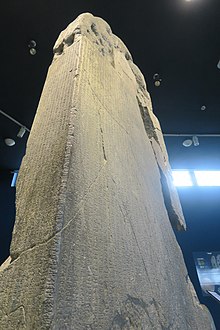Bilge Kağan Yazıtı
Bilge Kağan Anıtı, Bilge Kağan Kitabesi olarak da bilinir.
- Tür: Yazıt
- Tema: Orhun Yazıtları
- Kültür: Göktürk
- Yüzyıl: 8. yy
- Bölge: Moğolistan, Arhangay
| Orkhon inscriptions | |
|---|---|
| simplified Chinese: 阙特勤碑; traditional Chinese: 闕特勤碑; pinyin: Què tèqín bēi | |
 Kul Tigin Monument of Orkhon Inscriptions – Orkhon Museum, Kharkhorin, Mongolia | |
| Type | Memorial |
| Height | 3.3 metres (11 ft) |
| Width | 1.3 metres (4 ft 3 in) |
| Symbols | Old Turkic script |
| Created | 8th century |
| Discovered | 1889 Orkhon Valley, Mongolia 47°33′38″N 102°50′28″E / 47.56056°N 102.84111°E |
| Discovered by | Nikolay Yadrintsev |
| Present location | Bilge Khan and General Kul Tigin Complex |
The Orkhon inscriptions (also known as the Orhon inscriptions, Orhun inscriptions, Khöshöö Tsaidam monuments (also spelled Khoshoo Tsaidam, Koshu-Tsaidam or Höshöö Caidam), or Kul Tigin steles (simplified Chinese: 阙特勤碑; traditional Chinese: 闕特勤碑; pinyin: Què tèqín bēi)) are two memorial installations erected by the Göktürks written in the Old Turkic alphabet in the early 8th century in the Orkhon Valley in what is modern-day Mongolia. They were erected in honor of two Turkic princes, Kul Tigin and his brother Bilge Khagan.[1]
The inscriptions, in both Chinese and Old Turkic, relate the legendary origins of the Turks, the golden age of their history, their subjugation by the Tang dynasty, and their liberation by Ilterish Qaghan.[2] According to one source, the inscriptions contain "rhythmic and parallelistic passages" which resemble that of epics.[1]
- ^ a b Ross, E. Denison (1930). "The Orkhon Inscriptions: Being a Translation of Professor Vilhelm Thomsen's Final Danish Rendering". Bulletin of the School of Oriental Studies, University of London. 5 (4): 861–76. doi:10.1017/S0041977X00090558. JSTOR 607024. S2CID 140199091.
- ^ Krueger, John R. (1962). "The Earliest Turkic Poem". Journal of the American Oriental Society. 82 (4): 557. doi:10.2307/597528. JSTOR 597528.
